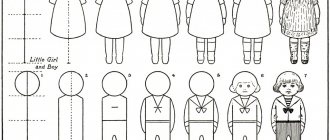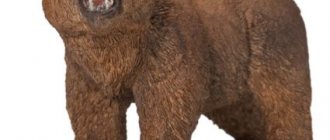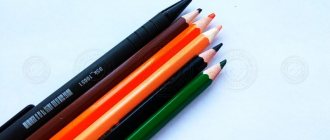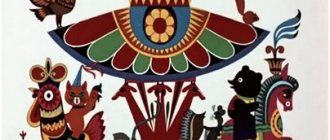Progress of the lesson.
— I’m glad to see all the children in our group healthy and cheerful! I really want you to remain in this mood until the evening! And for this we must smile more often and help each other! After all, every smile is a little sun that makes you feel warm and good.
-Dear guys, I want to invite you on an exciting journey through the corners of our Motherland.
Try to answer the question:
-What is the Motherland, native land? Why do you love her? (Children's answers)
The homeland is, first of all, the closest people - mother, father, grandmother, grandfather. This is your home, street, village where you were born and live. This is the kindergarten where you go, the teachers who surround you.
(Children show drawings about their native land, about nature, drawn together with their parents).
1st child: What do we call Motherland?
The house where you and I live,
And the birch trees along which
We walk next to mom.
Performance of "Song of the Motherland"
music V. Jelinek, lyrics. E. Karaseva.
— Guys, what is the name of our city? (Abakan)
2nd child: My Abakan! My capital!
My wonderful, dear city!
Nothing compares to you
I'm glad to see this city!
And today we will go on a trip by bus to the museum.
-Shall we begin our journey? But how do we get into the city? What can you go on a trip with? Let's go by bus. Using a counting rhyme, we will choose a driver.
Children take their seats on the bus and sing the song “Merry Travelers”
music M. Starokadomsky, lyrics. S. Mikhalkov hit the road. The children get off the bus.
-Here comes the museum, please. Go to the display case.
— Tell me, who is the most important person in our country? (The president)
-What do you think is his main task, what should he do first of all?
(So that in our country all peoples: Russians and Khakassians, and other nations live peacefully and amicably, work together)
— What is the name of the country in which we live? ( Russia )
- Name the capital of our homeland.
3rd child: I love you, Russia ,
I love you Moscow!
You, Moscow, are loved by everyone,
We all need you, Moscow.
— I want to tell you about Red Square. Here is the Kremlin, where the chimes are located, by which the whole country checks time, St. Basil's Cathedral, a monument to Minin and Pozharsky. It turns out that Red Square was first called Torg, since trade was carried out there. Currently, military parades and demonstrations are taking place on Red Square. Russian flag proudly flutters .
Showing the children the flag of the Russian Federation
Russian flag consists of three stripes of equal width. What do the colors on the flag mean?
4th child: White color – birch,
Red stripe – solar dawn.
— In Russia, these colors have been revered for a long time, and had their own symbolic knowledge: white - nobility, blue - honesty, red - courage and generosity.
Where else can we meet the Russian ?
(On ships, in the hands of athletes, soldiers)
- Let's play the game “Make the flag correctly”,
.
Two children participate in the game. Russian flag from strips of colored paper . The speed and correctness of completing the task is assessed.
— In addition to the flag, Russia also has its own coat of arms . (Children look at the coat of arms of Russia )
5th child: Russia has great
The coat of arms has a double-headed eagle,
So that to the west, to the east
He could have looked right away.
He is strong, wise and proud,
He is Russia's free spirit .
— The coat of arms of Russia is a dark red shield with a golden double-headed eagle on it. The coat of arms of Moscow is placed on the eagle's chest; it also has the shape of a shield. This means that Moscow is the capital of the powerful Russian state .
Where can you see the image of the coat of arms of Russia ?
(On documents and coins, children look at them)
- Guys, now we’ll take a little break and have a little physical education:
Zhura - zura - crane!
He flew over a hundred lands.
Wings, legs strained.
We asked the crane:
Where is the best land?
There is no better native land!
-Each state has its own anthem. This is the main song of the state, which is performed on special occasions. When the anthem is played, everyone stands up and men take off their hats.
(Children listen to an audio recording of the Russian )
— Our journey ends, we return to our beloved kindergarten by bus.
(Children get on the bus and arrive at kindergarten)
-There are many different states on our planet. Every person is a citizen of one country or another, is proud of his homeland, loves it.
And although you are still small children, you are already citizens.
But the most important task of all people on earth is to remember that there are many countries in the world, but we have one home, a common one, which is called planet Earth. We should all live here as good friends, respecting the traditions, culture, and customs of different countries and peoples.
-And now we will draw and color the Russian flag . Please come to the table and choose your favorite picture.
Determine what work each child will do (color with colored pencils, paints, cotton swabs or felt-tip pens)
On the topic: methodological developments, presentations and notes
Drawing project "Journey to the Land of Colors" junior preschool age.
Summary of joint educational activities with children of the senior drawing group “Journey to the Country of Fine Arts.”
During NOD, students become familiar with non-traditional drawing techniques.
Drawing with non-traditional techniques opens up wide scope for children's imagination. Paint only with a brush? But it's boring! I present an entertaining open event for preparatory activities.
Learning to draw fairy-tale characters using artistic expression.
Consultation for parents. "JOURNEY TO THE COUNTRY OF DRAWING."
Source
On the topic: methodological developments, presentations and notes
To form in children a sense of patriotism and love for their Motherland.
- to form in children an idea of Russia as a native country; - to form a respectful attitude towards state symbols; - to consolidate the names of folk crafts; - to cultivate a love for Ro.
The lesson notes are aimed at developing the fundamentals of citizenship, patriotism, and developing the child’s self-awareness about the history and culture of Russia.
Expand children's understanding of the small and large homeland. Consolidate children's knowledge about the present of the Fedorovsky village. Develop memory, intelligence, resourcefulness. Instill respect for traditions and about.
Introduction to symbols: coat of arms, flag, anthem.
To give children an idea of the Motherland, to expand and deepen children’s ideas about our country.
Source





